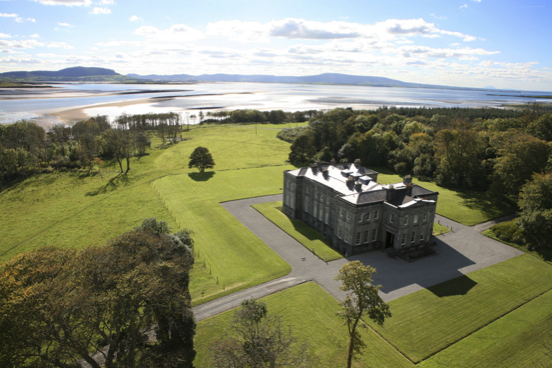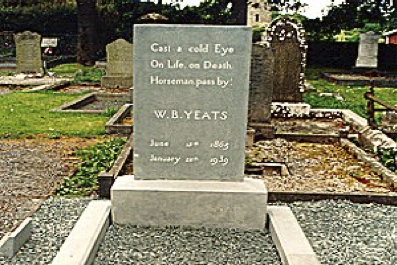HISTORIC HOUSES AND DEMESNES
Lissadell House & Yeats’ grave
Open from 2 May to 18 October from 10h30 -18h00,
with an admission fee of 12€ for a guided tour of the house.
Address: Lissadell, Ballinfull, County Sligo
E-mail: elle@lissadellhouse.com ou info@lissadellhouse.com
Tel.: 00 353 71 9163150

Directions : nonstop door-to-door, the trip by car from the house to Lissadell (lios and dall: stronghold of the blind man) takes exactly one hour. The road, although good, is rather charmless, however, hidden on the left are the scenic mountains of Leitrim and Sligo and on the right sandy a string of picturesque indented beaches, ideal for surfing and sea bathing if you don’t mind the water temperatures. On your way to your destination, it would be a shame not to stop off at John Lang’s Bar at Grange for a drink or lunch and, as the turn off to Lissadell is just before Drumcliffe (droim ciabh: ridge of baskets – set of hillocks), where William Butler Yeats is buried, why not include a brief pilgrimage to the poet’s grave, either on the way there or the way back?

With this in mind, we would advise leaving the house not later than 9h00 (the centre opens at 10h30). Take the bypass at Mountcharles and the N15 in the direction of Sligo, taking care to bypass Ballyshannon and Bundoran. It you have made an even earlier start, it would be worth turning off to make a quick visit to the scenic fishing village and holiday resort of Mullaghmore (mullach mor: big peak or summit), which was formally part of Lord Palmerstone’s estate and where his relation Lord Mountbatton and three Irish fishermen were blown up by the IRA in 1979.

Then, your next optional stop could be, the rather nondescript main-street town of Grange, for a quick cup of tea or coffee at Lang’s charming bar (071 9163105). You will find it just before the church and the traffic lights on the right. There is a convenient parking space behind. We would also chose it for lunch or dinner rather than Yeats’ tavern a little further on, which has an unjustified (in our view) reputation.

Grange is worthy of interest for two reasons (i) it is the place where, in 1588, on the sandy shores of Streedagh, three of the Armada galleons, the Lavia, the Juliana and the Santa Maria, went aground, The strand, a surfer’s paradise, is easily accessible from the village and an ideal spot to stretch your legs (ii) it has the unexpected distinction of being the birthplace of the adventuress Lola Montès, an Irish colleen who masqueraded as a Spanish dancer and caused, among other things the downfall of Ludwig of Bavaria.
Drumcliffe, where you should turn off to Lissadell is 7 kilometres down the road from Grange, but ignore the signpost marked “Carney, Lissadell” and continue on for a few minutes until you come to a church on your left, where you can spend 10 minutes contemplating the grave of William Butler Yeats and wandering around the visitors’ centre, which serves light refreshment and sells postcards and local produce. Then, make an about turn back towards Grange taking the first left turn, on your towards the pretty village of Carney (7 kilometres).
The entrance to Lissadell is the third on the left after the village, directly opposite the Anglican Church.
The land was seized from the O’Conor clan during the Elizabethan plantations and given to the Gore family. The house, considered to be fine example of Greek revival architecture, was designed by the English architect Francis Goodwin for the notorious Robert Gore Booth and his family and the construction took place between 1830 and 1835. To preserve the simple classical design there are no outbuildings near the house and no attic. The land was cleared of the crofters for the same reasons — they couldn’t have the ladies distressed by the spectacle of the starving natives.
Rooms in the house on view include the Bow Room, the Drawing Room, the Gallery, the Anteroom, the Imperial Staircase, the Billiard Room, and the First Floor West Rooms, which are devoted to the works of the poet William Butler Yeats and his brother, the painter Jack Butler Yeats. However, perhaps, the most amazing part of the house is the basement, where the running of the house took place; the place gives a far more realistic picture of what life below stairs was like in the nineteenth and early part of the nineteenth century than sycophantic Downton Abbey.
Steeped in the history of the period leading up to the 1916 uprising, the estate is, after 400 years, back in the hands of the native Irish. Heroically rescued from ruin in 2003 by Edward Walsh and Constance Cassidy, and despite an unfortunate incident with the Sligo County Council, it is being lovingly restored, with little or no help from the State, by the new owners, who are turning it into one of the most remarkable of Irish heritage centres.
On a fine day, apart from the guided tour of the house (45 minutes – well worth the 12 euros), the day can be spent wandering around the various exhibitions in the converted outbuildings set apart from the house, browsing in the souvenir shop and visiting the magnificent alpine gardens or walking on the beach. The tea-room like everything else is run by the family (whose private quarters are on the first and second floors; the young ladies of the family are excellent cooks and will provide you not only with a delicious snack lunch, but charming service. Or, if you wish, you can take a break, you can drive back to Carney, have something more substantial at Laura’s (071)9163056 and pursue your visit in the afternoon.